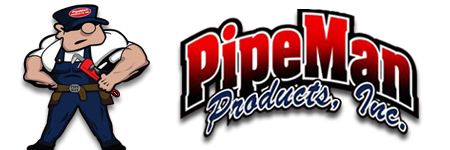1-877-PIPEMAN
1-877-747-3626
Hours: 7 AM to 4:00 PM Mon-Fri PST
Qwik Freezer CO2 Pipe Freeze Kit - FAQ

What are the benefits of a jacketed system?
Freeze jackets provide a wider freeze plug and can work with a 10-30 percent glycol line. Always test the contents of a line to see what the actual percentage of glycol is. It also takes more time to freeze than the chart shows.
What is the difference between the Arctic Freeze Kit and the Qwik-Freezer Pipe Freeze System?
The Arctic Freeze Kit is a good system for companies that do small to medium amounts of pipe freezing. The Arctic Freeze Kit sometimes have 1/2 the injection ports than the Qwik-Freezer System. The Qwik-Freezer System is for companies performing medium to larger amounts of pipe freezing.
What if I just have one job to freeze 5.00"-6.00" pipe right now? Can I just purchase that size for my current job but add more sizes for my kit later if I need to freeze a different sized pipe in the future?
Yes. You can always purchase the size you need now, and add to your freeze system as needed. The entire kit will allow you more versatility for your future pipe freeze jobs. However if you are performing one pipe freeze only, we will get you a quote for that size only.
What is the time frame for freezing pipe?
The tables below are for typical freezing of static water at 68° F in Schedule 40 steel pipe. Higher temperatures will require additional injection and waiting periods. Plastic pipe will take up to 3 times longer. Refer to Operating Manual for detailed instructions. For freezing applications on pipes larger than 9" (203mm) in diameter, please contact PipeMan Products, Inc.

What type of pipe can I freeze with the Qwik-Freezer System?
This unit freezes all types of liquids in steel, copper, cast iron, aluminum, plastic, ductile, and ACP (Asbestos/Cement) pipe. Please see the manual for the pipe freeze chart and adjust your times accordingly.
Can the Qwik-Freezer System freeze moving water?
No, All CO2 pipe freeze systems require that the water not be moving.
What is the best temperature in the line to freeze?
The charts are based on 68 degrees F. The warmer the line the longer it takes to freeze and the more CO2 that is needed. At some point the water will be too warm or hot to freeze. You can cool down the line faster with ice bags or dry ice to get the temperature down so it can freeze.
Do I need anything else to make this freeze?
Yes, it requires one or more 20lb. or 50lb. Dip Tube (Syphon tube) CO2 Cylinders (sold separately) so the liquid can flow onto the pipe and freeze it.
How cold does the Qwik-Freezer System freeze to?
CO2 freezes at minus 109 degrees F.
How can I isolate a line for repair, to replace a valve or extend out a new line without draining the system or causing a long shutdown?
This can be achieved through several different methods. The most popular way if the water in the line is not flowing is pipe freezing. Pipe Freeze Kits using CO2 are an inexpensive way to get the job done when draining the system is not an option. By pipe freezing you can place a 7000 PSI ice plug on one or both sides of your repair, complete the job and just let the ice plug thaw out. It just requires a pipe freeze kit and dip tube CO2 cylinders.
Can any of these pipe freeze kits freeze lines containing glycol (anti-freeze)?
The bag-style freeze kits have a greater chance of freezing lines containing small amounts of glycol, but not within the freeze times listed. Knowing the concentration of glycol is hard to determine; consider the antifreeze in your car that came from the factory with a known percentage of antifreeze in the radiator, but who knows what percentage that is after years of use and adding fluids. Whenever dealing with glycol it is highly recommended that you obtain a sample of the line contents and perform a test freeze with the same type of pipe in a controlled environment. This test will help you determine how long it will take to get the line to freeze and how much CO2 will be needed to perform the freeze on the job site.
Back to Product Page


